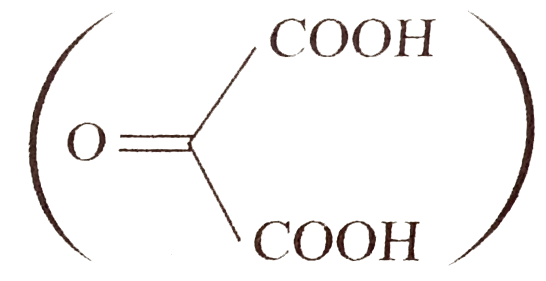A compound A(C2H6O) on oxidation by PCC give B, which on treatment with aqueous alkali and subsequent heating furnished C. Bon oxidation by KMnO4, forms a monobasic carboxylic acid with molar mass 60 g mol−1 Deduce the structures of A, B and C.
Monobasic carboxylic acid = RCOOH Given that, molar mass of RCOOH = 60 g mol−1 i.e.x+12+16+16+1=60=x=15
Thus, R=−CH2 (molar mass 15) and the acid is CH,COOH. Since, the acid is obtained by the oxidation of aldehyde, so Bis an aldehyde, i.e. CH,CHO and A is CH3CH2OH. Thus, the reactions are as follows:
CH3−CH2(A)−OHPCC−−→CH3−O∣∣C(B)−HKMnO4−−−−→CH3−O∣∣C−OH(M, wt. 60 gmol−1)
2CH3−O∣∣C(B)−HOH−−−−−−−−−−−−→Aldol condensation CH3−OH∣CH−CH2↓Heat−O∣∣C−H
CH3−CH=(C)CH−O∣∣C−H
Similar Questions
Compound (A) (C6H12O2) on reduction with LiAlH4 yielded two compounds (B) and (C ). The compound (B) on oxidation gave (D), which on treatment with aqueous alkail and subsequent heating furnished (E ). The latter on catalytic hydrogenation gave (C ). The compound (D) was oxidised further to give (F) which was found to be a monobasic acid (molecular formula weight =60.0). Deduce the structures of (A), (B), (C ), (D), and (E ).
View SolutionCompound (A) (C6H12O2) on reduction with LiAlH4 yielded two compounds (B) and (C ). The compound (B) on oxidation gave (D), which on treatment with aqueous alkail and subsequent heating furnished (E ). The latter on catalytic hydrogenation gave (C ). The compound (D) was oxidised further to give (F) which was found to be a monobasic acid (molecular formula weight =60.0). Deduce the structures of (A), (B), (C ), (D), and (E ).
View Solution
Knowledge Check
An aromatic compound 'A' on treatment with aqueous ammonia and heating forms compounds 'B' which on heating with Br2 and KOH forms a compound 'C' of molecular formula C6H7N.
The conversion of B to C isAHoffmann bromamide degradation reactionBBromoform reactionCWurtz fitting reactionDHoffmann mustard oil reaction
Compound A (C6H12O2) on reduction with LiAlH4, yielded two compounds B and C. The compound B on oxidation gave D which upon treatment with aqueous alkali and subsequent heating furnished E. The latter on catalytic hydrogenation gave C. The compound D was oxidised further to give F which was found to be a monobasic acid (molecular) formula weight = 60. Deduce the structures of A, B, C, D and E.
View SolutionCompound A (C6H12O2) on reduction with LiAlH4, yielded two compounds B and C. The compound B on oxidation gave D which upon treatment with aqueous alkali and subsequent heating furnished E. The latter on catalytic hydrogenation gave C. The compound D was oxidised further to give F which was found to be a monobasic acid (molecular) formula weight = 60. Deduce the structures of A, B, C, D and E.
View SolutionMnO2 on reaction with dilute sulfuric acid gives
View SolutionCompound (A)(C12H16) on oxidation with acideic KMnO4 solution gives acetone and
 . Identify compound (A).
. Identify compound (A).
View SolutionCompound (A)(C12H16) on oxidation with acidic KMnO4 solution gives acetone and
 . Identify compound (A).
. Identify compound (A).
View SolutionA compound [A] of molecular formula C4H9Br yields a compound [B] of molecular formula C4H10O when reated with aqueous NaOH. On oxidation [B] gives a ketone [C]. The vigorous oxidation of ketone gives ethanoic acid. Deduce the structure of A, B and C.
View SolutionA compound [A] of molecular formula C4H9Br yields a compound [B] of molecular formula C4H10O when reated with aqueous NaOH. On oxidation [B] gives a ketone [C]. The vigorous oxidation of ketone gives ethanoic acid. Dutuce the structure of A, B and C.
View Solution
